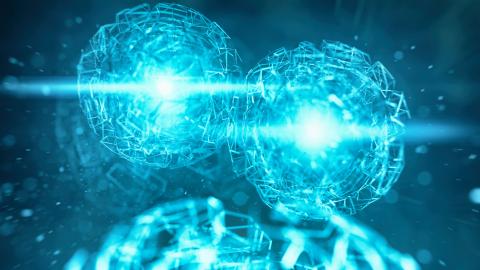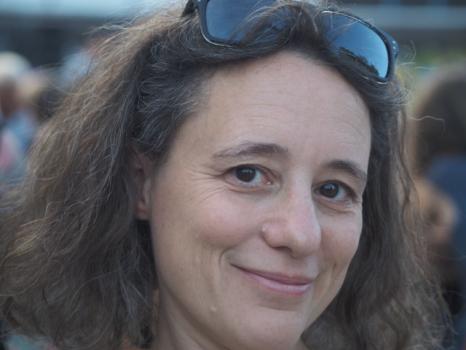
Fabienne Goldfarb, from light-matter interaction to laser dynamics
Fabienne Goldfarb is a lecturer at the Light, Material and Interfaces Laboratory (LuMIn - Université Paris-Saclay, ENS Paris-Saclay, CNRS, CentraleSupélec) and Deputy Director of Education at the Institute for the Sciences of Light. She works on very fundamental questions related to light-matter interactions and is also committed to working on the applicative potential of her research.
Although Fabienne Goldfarb knew in high school that she wanted to devote herself to physics research, it was during her higher education at Université Paris-Sud (now Université Paris-Saclay) that her vocation became clear. "While some of my fellow physicists dreamed of large projects and big instruments, I always preferred to work on experiments that I could control from A to Z, in teams where we knew each other well, where we combined theory and practice, and where, to put it simply, we had the opportunity to get our hands dirty!" says Fabienne Goldfarb from the outset. She decided very early on to focus on low energy physics. This choice led her to complete a DEA (now equivalent to a Master's degree) in quantum physics at Université Pierre et Marie Curie (now Sorbonne Université), and then to write a thesis on the interference of matter waves with electrons. This was followed by a postdoctoral stay at the University of Vienna, also devoted to matter wave interference but this time with neutral macromolecules. In 2005, she was recruited as a lecturer at Université Paris-Sud, where she joined the Aimé Cotton Laboratory (LAC - Uni. Paris-Saclay, CNRS) and then the LuMIn laboratory created on 1 January 2020.
Understanding the interaction between light and matter
Fabienne Goldfarb's career at the Aimé Cotton Laboratory began with very fundamental research on light-matter interaction, nonlinear optics and quantum optics. "I was particularly interested in the phenomenon of electromagnetically induced transparency (EIT) and the problems of storing light in metastable helium, a very interesting medium from a fundamental point of view, but one that cannot be used for quantum memory applications. I had the chance to set up an experiment that did not exist and which, fifteen years later, I still rely on with new objectives," explains the lecturer.
The emergence of an engineering dimension
In parallel with her work on metastable helium, Fabienne Goldfarb began working on questions related to laser dynamics around 2010. "The idea was to work on the creation of very low noise continuous lasers emitting at two frequencies." She began collaborating with Thales Research and Technology (TRT) on this work, which allowed her to develop a deeper, more applied dimension around microwave optics for potential future radar and radio frequency applications. "Although this work was still in the field of fundamental research into laser physics, it was at this time that an engineering dimension began to emerge in my career, and would subsequently develop," adds Fabienne Goldfarb. From 2011 to 2015, the lecturer was also the coordinator of PhD training quality control and worked on the administrative follow-up of the stays of foreign researchers at Université Paris-Saclay.
In search of potential applications
In 2020, when the Aimé Cotton Laboratory was restructured into two laboratories, Fabienne Goldfarb helped to create one of them, the Light, Material and Interfaces Laboratory (LuMIn), which has a multidisciplinary nature and strong links with industry. "At LuMIn, we have a joint laboratory with Thales Research and Technology in which we regularly collaborate on very early-stage topics and study their application potential. For example, based on the phenomenon of electromagnetically induced transparency we are currently working together on the study of possible Rydberg atom sensors for the detection of radiofrequency fields," adds the lecturer who is continuing her work on light-matter interaction, via spin noise spectroscopy, at the same time.
Experimental teaching
Assigned to the Orsay Technical Institute when she was recruited as a lecturer, since 2005 Fabienne Goldfarb has been teaching optics to students of the university technology diploma (DUT) in physical measurements alongside her research work. She is one of those lecturers for whom research and teaching are two activities that should feed off each other. "I am convinced that it is always possible to use what we do in research in experimental teaching, even at undergraduate level. For example, as part of my technology-oriented teaching, I had the opportunity to design practical work studying the advanced optoelectronic components used in my research." In addition to her courses, Fabienne Goldfarb has been in charge of continuing education and monitoring the validation of acquired experience (VAE) for many years. "This is an excellent way for me to maintain a link between the academic world and the industrial world, including on the teaching side!"
Making the sciences of light shine
And since nothing seems to stop her, since 2020 Fabienne Goldfarb has also been Deputy Director of Education at the Institute for the Sciences of Light. Building on the decades-long tradition of fundamental research and training in optics at Université Paris-Saclay, this cross-functional "virtual" institute has set itself the primary role of fostering synergies between the players in the ecosystem and contributing to advances in the sciences of light in all fields, from the most fundamental to the most applied. "With some 700 researchers and lecturers working in 26 laboratories and six Graduate Schools, and nearly 200 engineers and 60 PhDs graduating each year, all specialised in the field of light, it is true that the task is immense and the challenge exciting!" enthuses Fabienne Goldfarb. On the education side, a call for tenders has been put in place to facilitate acculturation between engineering schools and universities by financing the apprenticeship of engineering students in laboratories. "We are also working to set up recurring conferences and specialised schools with our foreign partners for our young colleagues - PhD candidates - with whom it is always exciting to work, as they make us learn so much," concludes Fabienne Goldfarb.

